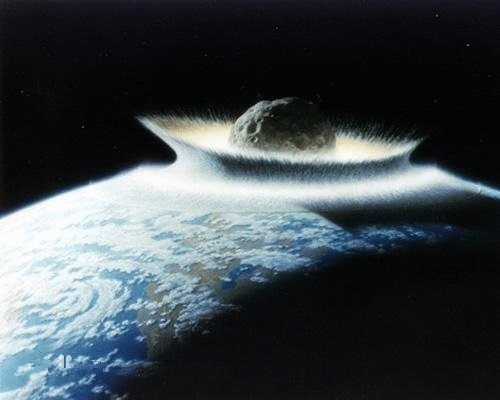From the depths of space, an asteroid hurtles toward Earth. (Well, our general vicinity.)But this is no ordinary hunk of galactic debris. Because the body of this asteroid seems to defy gravity. It's bound by forces never observed on this scale in space.
在太空深處,一顆小行星急速駛向地球。(當(dāng)然,只是駛向與我們大致鄰近的區(qū)域。)這可不是塊普通的銀河碎片。因?yàn)檫@顆行星天體似乎不受地心引力的作用。它所受的凝聚力在這片太空區(qū)域中可謂前所未有。
That's not the plot of a new summer blockbuster. It's the result of a study in the journal Nature.
這不是暑期大片里的一個(gè)橋段,而是《自然》雜志中發(fā)表的一項(xiàng)研究結(jié)論。
The asteroid in question is actually a kilometer-sized collection of rubble. In most cases, such space — faring pebble piles are held together by a combination of gravity and friction. But not so for our rocky interloper, dubbed "1950 DA." This asteroid is rotating so rapidly that its pieces should have flung apart long ago.
這個(gè)神秘的小行星事實(shí)上是個(gè)大小為一公里的碎石堆。通常,這種遨游在太空中的碎石堆是通過(guò)重力和摩擦力聚合在一起的。但我們眼前這個(gè)被命名為“1950 DA”的入侵者卻不是。它旋轉(zhuǎn)得如此迅速,其中的碎石塊應(yīng)該早被甩掉了才對(duì)。

Now, by analyzing the 1950 DA's temperature and density, researchers conclude that cohesive forces called van der Waals attractions must be keeping the pieces clustered. Van der Waals forces may sound mysterious, but they're well known on the small scale for their weak influence within and between molecules.
通過(guò)分析1950 DA的溫度和密度,研究人員得出這樣的結(jié)論:使得碎石塊凝聚在一起的肯定是范德華引力。范德華引力聽(tīng)起來(lái)可能有點(diǎn)令人費(fèi)解,它因能在小范圍內(nèi)對(duì)分子或分子間起微小作用而聞名。
Blasting the asteroid, Hollywood style, could overcome these forces. But that might leave us with hundreds of smaller killer space rocks to dodge. The good news is, the asteroid won't be in our area until 2880. So we have some time to figure it out.
將小行星爆破?——好萊塢大片的一貫作風(fēng),興許能擺脫這些引力。但這樣一來(lái),我們得躲避數(shù)以百計(jì)掉落下來(lái)的致命隕石。值得高興的是,該小行星到2880后才會(huì)遠(yuǎn)離地球。所以我們還有一些時(shí)間來(lái)找出答案。











